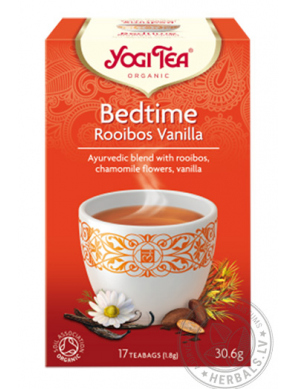Products
- Ayurvedic tea
- Indian teas
- Supplements
- Oils and drinks for health
- Facial Care
- For Skin
- Dental care
- For personal hygiene
- Sport and Yoga
- For Hair Health
- For massage
- Healthcare
- For Women
- Supplements for Men
- Aromatherapy Essential Oil
- Incense sticks
- Indian Food
- Vegan
- Superfoods
- For meditation
- For home
- New Products
- Specials
- Ayurvedic Herbs
- Wholesale
- Gifts and Kits
Browser notifications:
Yogi tea Bedtime Roobos Vanilla
Yogi tea Bedtime Roobos Vanilla pac 2g N 17
We all are looking for soothing ways to relax and unwind in the evening and to have a good restful night’s sleep. YOGI TEA® Bedtime Rooibos Vanilla combines sweet creamy rooibos, chamomile and lemon balm with cacao shells, sweet vanilla and a hint of nutmeg in this deliciously comforting tea.
Relax and breathe in the enchanting aroma of YOGI TEA® Bedtime Rooibos Vanilla. This delicious blend with its soothing, warm flavour is just perfect for drinking before bedtime, or whenever you need that extra relaxing touch. Sweet dreams!
Ingredients:
Rooibos* (33%), chamomile* (32%), cocoa shells*, liquorice*, vanilla extract* (3%), cinnamon*, cardamom*, lemon balm extract*, nutmeg*, rose petals*, ginger*, cloves*, black pepper*.
*from controlled organic cultivation
Ingredients
We all are looking for soothing ways to relax and unwind in the evening and to have a good restful night’s sleep. YOGI TEA® Bedtime Rooibos Vanilla combines sweet creamy rooibos, chamomile and lemon balm with cacao shells, sweet vanilla and a hint of nutmeg in this deliciously comforting tea.
Relax and breathe in the enchanting aroma of YOGI TEA® Bedtime Rooibos Vanilla. This delicious blend with its soothing, warm flavour is just perfect for drinking before bedtime, or whenever you need that extra relaxing touch. Sweet dreams!
Ingredients:
Rooibos* (33%), chamomile* (32%), cocoa shells*, liquorice*, vanilla extract* (3%), cinnamon*, cardamom*, lemon balm extract*, nutmeg*, rose petals*, ginger*, cloves*, black pepper*.
*from controlled organic cultivation
Ingredients
- Rooibos. To this day, the redbush - which is also called rooibos - from the legume family is cultivated exclusively in the cedar mountains of South Africa. Growing to a height of two metres, the plant is only harvested once every year. Its leaves are made into rooibos tea, which is the mild-fruity and slightly sweet tasting national beverage of South Africa.
- Chamomile flowers. It was sacred for the Teutons and the flower of Sun God Ra for the Egyptians: the white feathered chamomile with its brilliant yellow petals. Chamomile is an herbaceous plant, the typical fragrance of which everyone knows. Its flowers taste slightly bitter and pleasantly mild.
- Vanilla. The "queen of spices" is among the most popular aromas in the world. It belongs to the orchidaceae family and is native to Mexico and Central America. Its subtle taste and elaborate processing make the genuine vanilla into an especially precious spice plant.
- The cocoa tree, which originally came from the Latin American rainforest, is primarily famous for its beans – the basic raw material of chocolate. But the shells of the cocoa bean fruit are also bursting with a sweetish-soft aroma and contain much fewer calories.
- Liquorice has already been known since ancient times. Its sweetening power is about 50 times stronger than that of sugar. It tastes mild-sweetish and bitter-tart.
- Cinnamon is among the most expensive spices in the world and was supposedly already used as a spice in China in 3,000 B.C. Cinnamon is extracted from the bark of the South-Asian cinnamon tree. It has an aromatic-sweetish taste and contains valuable essential oils.
- Cardamom has been one of the most popular spices for thousands of years throughout the entire Asian and Arabian area. Its subtle, sweetish-spicy aroma predestines cardamom for use in many different foods ranging from sharp curries to spicy Christmas biscuits.
- Lemon balm. Bees love its nectar-rich fruit, and human beings appreciate the spicy-fresh, lemony taste of its leaves. In the Middle Ages, lemon balm was so highly valued that it had to be cultivated in every European monastery garden per decree.
- Mace is the shell of the nutmeg. Whether dried or ground, it has been used as a seasoning for many thousands of years. Its aroma is somewhat more subtle than that of nutmeg. It tastes spicy-warm and is extremely popular especially in the colder season.
- Ginger. Whether in the Christmas biscuits, as a curry mixture or in lemonade: The bulbous ginger is among the best-known spice plants in the world. For thousands of years, it has been cultivated in the tropical heat of eastern Asia. It gives many of our YOGI TEA®s a fruity-hot and aromatically spicy taste.
- Cloves are the flower buds of the clove tree and primarily familiar as a spice for both sweet and salty food in the European part of the world. They belong to the myrtle family and have an intensive spicy aroma. They were even worth their weight in gold in both old China and Egypt.
- Also called the "king of spices," black pepper is one of the world's most important spices in addition to salt. It originally came from the Indian Malabar Coast and tastes intensive-spicy, ranging from slightly spicy to quite spicy.
Also bought
 OBESLIM Tea Arvin's 20 tea bags
3.00€
Tea Obeslim effectively strengthens the muscles of the body and normalizes weight
OBESLIM Tea Arvin's 20 tea bags
3.00€
Tea Obeslim effectively strengthens the muscles of the body and normalizes weight
 TULSI MASALA TEA 100g
12.90€
An exotic blend of spices, black tea and Tulsi leaves
TULSI MASALA TEA 100g
12.90€
An exotic blend of spices, black tea and Tulsi leaves
 Yogi tea ABEND - Bedtime
4.90€
Quiet night. Relieves stress and anxiety, eliminates insomnia
Yogi tea ABEND - Bedtime
4.90€
Quiet night. Relieves stress and anxiety, eliminates insomnia
Top sellers
 Yogi tea Detox
4.90€
Cleansing the body
Yogi tea Detox
4.90€
Cleansing the body
 SAMAHAN LINK tea
6.50€
SAMAHAN tea - helps to overcome the flu
SAMAHAN LINK tea
6.50€
SAMAHAN tea - helps to overcome the flu
 Yogi tea ABEND - Bedtime
4.90€
Quiet night. Relieves stress and anxiety, eliminates insomnia
Yogi tea ABEND - Bedtime
4.90€
Quiet night. Relieves stress and anxiety, eliminates insomnia
This item has been added to cart.










